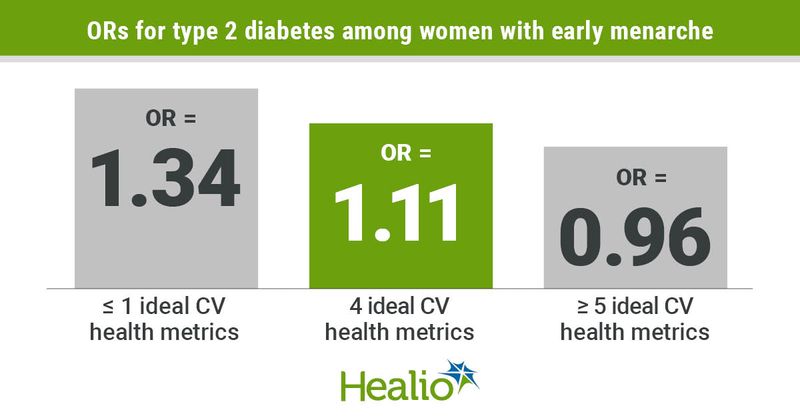Early menarche, fewer CV health metrics increase risk for type 2 diabetes
Women from China who had early menarche were more likely to develop type 2 diabetes as adults, with the risk higher for those with nonideal cardiovascular health, according to data from the REACTION study.
“Our study further indicated that early age at menarche was associated with an increased risk of diabetes in adulthood,” Jieli Lu, MD, PhD, of the Shanghai Institute of Endocrine and Metabolic Diseases, Ruijin Hospital, Shanghai Jiao Tong University School, and colleagues wrote in a study published in the Journal of Diabetes. “More importantly, the increased risk of diabetes related to earlier age at menarche was significantly attenuated among individuals with four or more ideal CV health metrics. There was a clear interaction between the number of ideal CV health metrics and the age at menarche on the risk of diabetes.”

Measuring ideal CV health
In the REACTION study, researchers recruited 259,657 adults aged 40 years or older from 25 locations across China in 2011 and 2012. For this study, data were analyzed from 121,431 women (mean age, 56.96 years) who took part in the study. Participants provided sociodemographic information, lifestyle factors, medical history and reproductive history in a series of questionnaires. All participants underwent a physical examination, had blood and plasma samples collected, and underwent an oral glucose tolerance test.
Researchers tallied the number of ideal CV health metrics for each participant. Ideal CV health was defined by five components:
- having never smoked or quit smoking for at least 1 year;
- having a BMI of less than 24 kg/m2;
- participating in at least 150 minutes of moderate-intensity physical activity or 75 minutes of vigorous activity per week;
- recording a dietary score of three or higher; participants received a point each for consuming 4.5 or more cups of fruits and vegetables per day, at least 198 g of fish per weeks, no more than 450 kcal of sweet or sugar-sweetened beverages per week, and at least 25 g of soy protein per day; and
- having an untreated total cholesterol level of less than 200 mg/dL and an untreated blood pressure of less than 120/80 mm Hg.
Early menarche and diabetes
Type 2 diabetes was prevalent in 23.73% of women who had early menarche at younger than 14 years, 23.39% in those who had menarche from age 14 to 17 years, and 26.37% in women who had late menarche at older than 17 years. After adjusting for age, education, drinking status, family history of diabetes, reproductive factors and number of CV health metrics, women in the early menarche group were more likely to develop diabetes as adults than those who had menarche from age 14 to 17 years (adjusted OR = 1.22; 95% CI, 1.17-1.28), whereas those in the late menarche cohort were less likely to develop diabetes (aOR = 0.89; 95% CI, 0.85-0.93).
“Potential mechanisms underlying the association of age at menarche and the risk of diabetes have been proposed,” the researchers wrote. “Early age at menarche was associated with higher cumulative exposure of estrogen, which may decrease serum sex hormone-binding globulin levels, while high plasma estradiol and low sex hormone-binding globulin levels may be associated with an increased risk of diabetes. ... Higher accumulation of progesterone induced by earlier menarche may impair the function of insulin-secreting cells through oxidative stress-dependent mechanisms, suppress insulin release and glucose transporter-4, leading to insulin resistance and diabetes. Furthermore, epidemiological studies also confirmed that earlier age at menarche was associated with higher risk of obesity, insulin resistance and nonalcoholic fatty liver disease.”
CV health associated with diabetes
Total cholesterol and BP influenced the risk for developing diabetes. In the early menarche group, the odds of developing diabetes were higher for those with nonideal total cholesterol (OR = 1.3; 95% CI, 1.22-1.4) than those with an ideal cholesterol level (OR = 1.16; 95% CI, 1.08-1.23; P = .0091). Women with a nonideal BP level were also more likely to develop diabetes (OR = 1.25; 95% CI, 1.19-1.32) than those with ideal BP (OR = 1.13; 95% CI, 1.03-1.26; P = .0019).
The prevalence of diabetes was higher among participants with fewer ideal CV health metrics. Women with early menarche and one or no ideal metric had the highest risk for developing diabetes (OR = 1.34; 95% CI, 1.15-1.57), whereas those with early menarche and four ideal metrics (OR = 1.11; 95% CI, 0.999-1.24) and five or more ideal metrics (OR = 0.96; 95% CI, 0.8-1.16) did not have an increased risk. The association was similar across different generations, although researchers noted estimates were higher for younger generations than older ones.
“Our study emphasizes the importance of healthy lifestyles promotion and comprehensive management of metabolic factors, including BP and total cholesterol levels, in the prevention of type 2 diabetes,” the researchers wrote.
